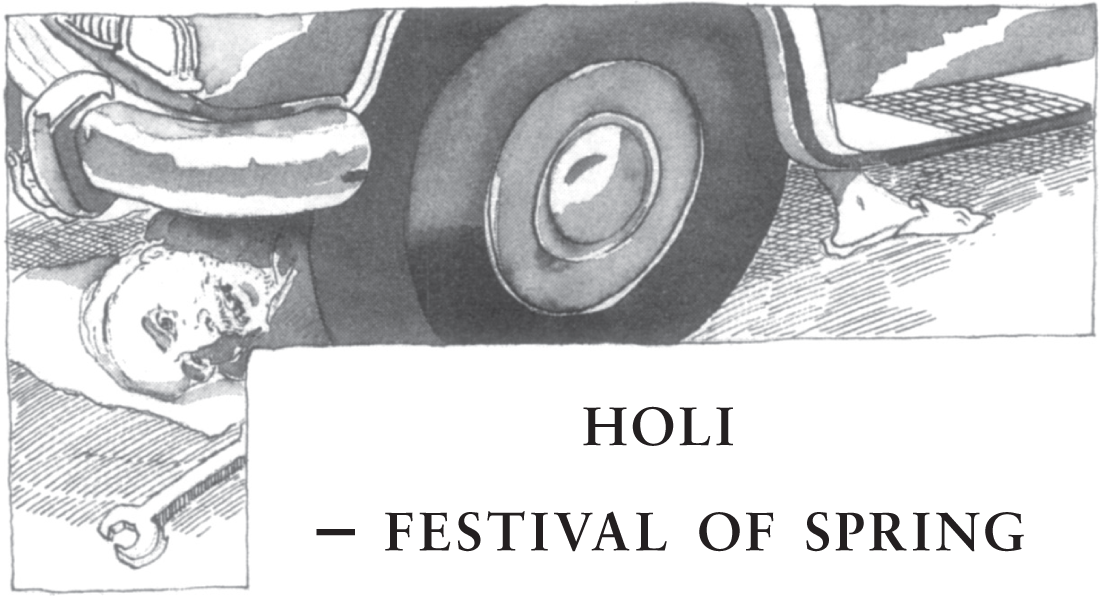
Holi is the Indian Spring Festival, a time when winter crops, such as wheat and mustard seeds, are harvested.
I cannot tell you how much I looked forward to this festival. In fact, I longed for it a good three hundred and sixty-four days of the year.
The reason was that our whole family did such unusual things to celebrate Holi.
First of all, on the day of the full moon around late February or early March, we built a huge bonfire. This was called ‘burning Holi’, because on this day, ages ago, a wicked princess, Holika, was consumed by flames that she had intended for her innocent nephew Prahlad.
Frankly, I cared less for Holika, who was burnt in ancient history, than I did for the stuff we actually threw into our own bonfire. We threw whole sheafs of green wheat, whole bundles of green chickpeas, still on their stalks, pine cones filled with strategically hidden pine nuts, and then watched them as their skins got charred.
Only the outside skins were allowed to burn. That was the trick. Each one of us then used a stick to pull out whatever we wanted to eat. My favourite was the chickpeas – tiny chickpeas still in their green skins. Of course, the skins would turn brownish-black but the peas themselves would be deliciously roasted. Everything would be hot – we would almost burn our fingers trying to peel the chickpeas and remove the shells from the pine nuts. Their taste would have to last us for the rest of the year as we licked our lips and remembered. By the end of it all, our faces were black and our clothes and hands were sooty, but no one seemed to mind, not even our parents.
The funny thing about Holi was that we could ‘burn’ it one night and ‘play’ it the next morning. While the ‘burning’ had to do, naturally, with fire, the ‘playing’ had to do with water and colours.
It was said that Lord Krishna, the blue god, played Holi with the milkmaids, so who were we to do any less?
As the Spring Festival approached, an army of us young cousins would, in great secrecy and in competing groups, begin its preparation of colours.
At Holi, all Indians, of all ages, have the licence to rub or throw colours – water-based, oil-based or in powder form – on the victims of their choice. No one is considered worthy of exemption, dignified grandmothers included.
Holi is a leveller, and there was no one we wanted to level more than those against whom we held grudges. A special ugly colour was prepared for them.
First, we would go to the garage and call on one of the chauffeurs.
‘Masoom Ali? Masoom Ali?’ we would call.
Masoom Ali would poke his head out from the pit under the gleaming Ford. ‘I am busy. Why are you children always disturbing me? Always coming here to eat my head. Barrister Sa’ab, your grandfather, wants the car at noon and I still have much work to do.’
‘Just give us some of the dirtiest grease from under the car.’
‘So, Holi is upon us again? Why don’t you children use the normal red, green and yellow colours?’
‘If you give us the grease, we won’t spray you with the awful magenta paint we have prepared in the garden watertank. It is a fast colour too.’
‘Threatening an old man, are you! All right, all right. Just stop annoying me.’
The grease would be combined with mud, slime and permanent purple dye. The concoction would be reserved for the lowliest enemies. Elderly relatives got a sampling of the more dignified, store-bought powders, yellow, red and green. For our best friends, we prepared a golden paint, carefully mixing real gilt and oil in a small jar. This expensive colour, would, as I grew older, be saved only for those members of the opposite sex on whom I had the severest crushes – transforming them, with one swift application, into golden gods.